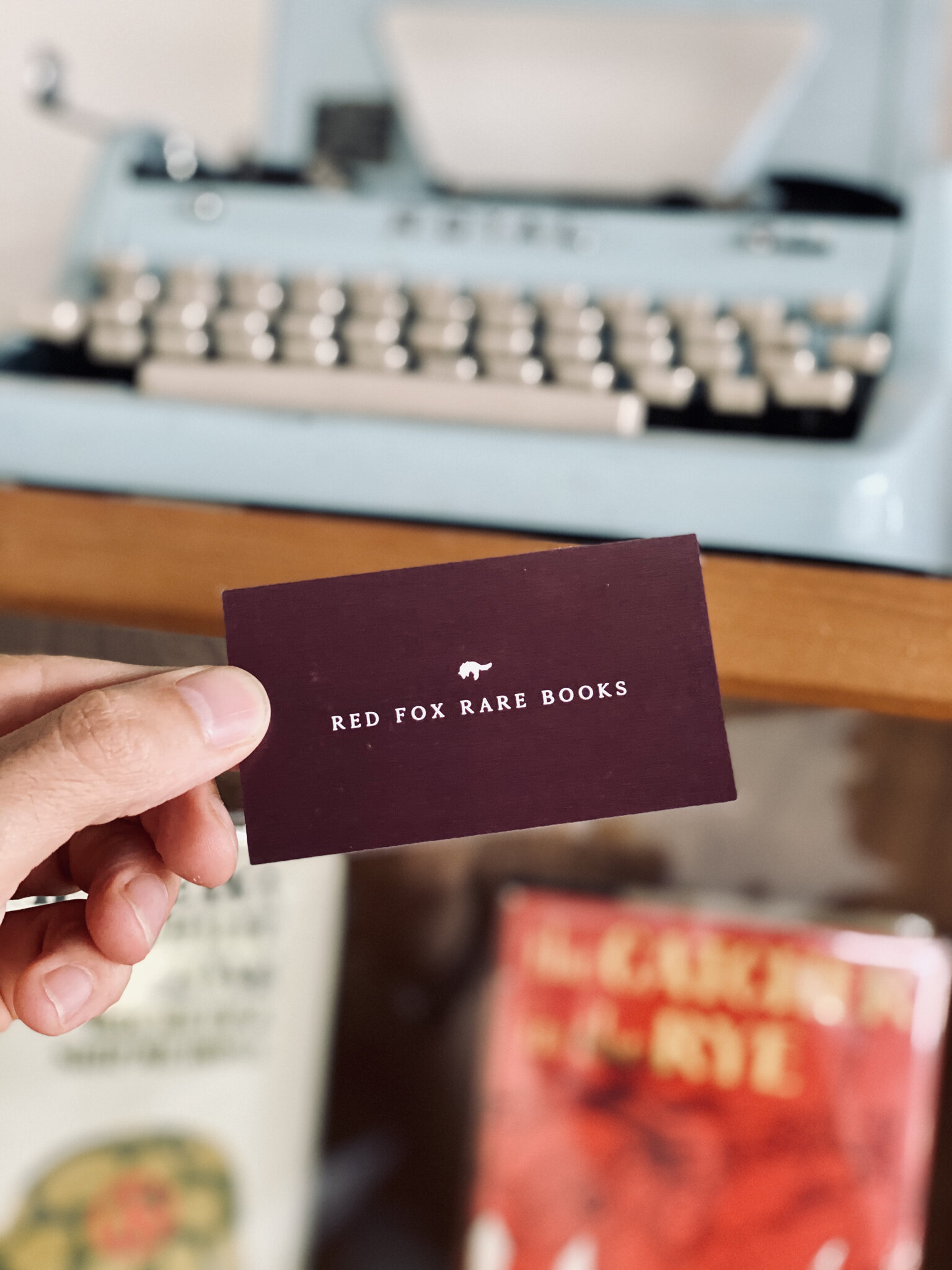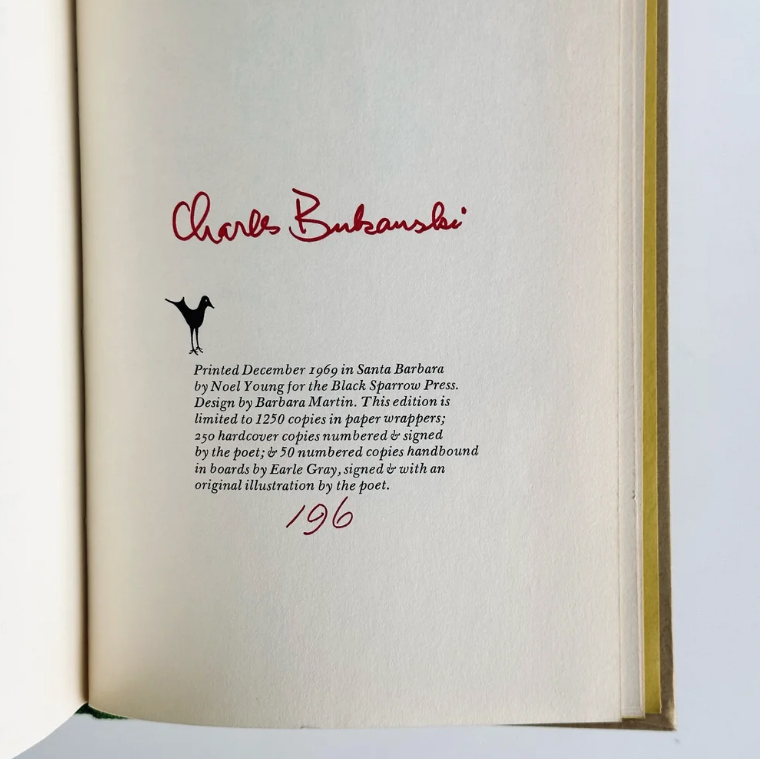Signed vs. Inscribed: What’s the Difference and Why It Matters
In the world of rare and collectible books, a signature can transform a great copy into something truly extraordinary. But as any serious collector soon discovers, not all author signatures are created equal. The difference between a signed and an inscribed copy may seem subtle — a few extra words on the title page — yet that distinction can mean thousands of dollars in value and reveal a fascinating story about the book’s journey from the author’s hand to yours.
So what exactly separates a signed copy from an inscribed one, and why does it matter so much to collectors?
Inscribed with a quote: “I have to return some videotapes… Bret Easton Ellis”
Signed, Limited: “Charles Bukowski” 196 (of 250 copies)
What Does “Signed” Mean?
A signed book is one that the author has simply signed (autographed) their name, usually on the title page, half-title, or a dedicated limitation page in the case of limited editions. Sometimes in signed limited editions a signature may be found on the rear colophon, as well. Ideally the signature is clean, minimal, and often added at a formal signing, launch event, or through the literary agent or publisher’s arrangement.
Collectors prize these copies because they represent a direct, authenticated connection to the author without any personal message that could distract from the book itself. A simple signature, often referred to in the book trade as “flat signed”, when placed neatly and without a personally dedicated inscription, is often considered the most desirable form of author autograph.
Inscribed: “Best Wishes, D.K. Mano”
Example:
A copy of One Hundred Years of Solitude by Gabriel García Márquez that bears only his bold, looping signature on the title page would be described as “signed by the author.” Such a copy, especially in fine condition and from an early printing, could be worth many times the price of an unsigned one.
Flat signed: “Ernest Cline”
What Does “Inscribed” Mean?
An inscribed copy includes a personal message in addition to the signature — something like a quote from the book, a witty quip, or simply “best wishes”. A dedication would include something like —, “To John & Jane, with best wishes – Ernest Hemingway.” In the trade, this is often referred to as a presentation copy.
While inscriptions make the book more personal, they also make it more specific — and that can either increase or decrease its desirability, depending on the circumstances.
Inscribed with quip: “Keep on Reading! S.E. Hinton, dated 1995”
Some collectors love flat signed copies, while some prefer lengthy inscriptions. There is always a variance when it comes to value and preference, however, flat signed copies tend to be more consistent with demand. However, if the inscription reveals something meaningful — for instance, if it’s addressed to a close friend, a collaborator, or a famous figure — the book can become exceptionally valuable and sometimes historically significant. Some authors create doodles, others write comedic, touching or even vulgar messages in their inscriptions - and some collectors delight in finding them.
Example:
An inscribed copy of The Old Man and the Sea reading “To Charles Scribner, with love, Ernest Hemingway” would be far more valuable than a mere signed copy, because of the connection between Hemingway and his publisher. This would make that copy, in a way, one-of-one.
Inscribed and personalized with message: “Jenny: the universe will help you to find your treasure, Paulo Coelho”
Graphic doodle, date, location, dedicated and personalized: “To Tim, stop lying & get a job — you’re fucking up the children. Good luck, HST “Doc”
How Condition and Context Affect Value
When assessing the value of a signed or inscribed copy, context is everything.
A few key factors that influence desirability include:
Recipient: Who was the book inscribed to? A note to a friend, family member, or another famous person adds historical value.
Content of the Inscription: Does it reveal anything personal, witty, or relevant to the book? Unique messages can make a copy one-of-a-kind.
Association copy: this book is flat signed by the director of the film adaptation of the novel, signed “David Cronenberg”
Placement: Where the signature or inscription appears matters — most collectors prefer it on the title page rather than the endpapers.
Condition: As always in rare books, condition reigns supreme. A pristine dust jacket or bright pages can make all the difference. Also: what is the condition of the signature? Is it clearly legible? Is it in pen or marker? Is it the author’s name in full or is it abbreviated? These are all factors to consider.
Edition: A signature or inscription on a true first edition carries far more weight than one on a later printing.
Signed vs. Inscribed: Which Should You Collect?
Ultimately, the choice comes down to personal preference and your collecting goals and philosophy.
If you value purity, simplicity, and investment potential, a signed copy — clean and unpersonalized — is often the safer bet. These appeal to a wider range of buyers and tend to maintain strong value.
If you value story, character, and human connection, an inscribed copy can be far more rewarding. The author’s words, even if brief, transform the book into a piece of history.
Some collectors build entire collections around presentation copies, seeking books inscribed to notable figures, critics, or contemporaries — the kinds of volumes that illuminate literary networks and relationships.
Others prefer signed limited editions, often produced in small numbers, where the signature is guaranteed authentic and condition is easier to preserve.
Signed, Limited: “Joseph McElroy” 65 (of 99 copies)
Authenticity Matters
In both cases, verifying authenticity is crucial. For modern authors, signatures are relatively easy to authenticate; for earlier or more valuable works, provenance (the book’s ownership history) and comparison with known examples are essential. It takes a trained eye to distinguish forgeries from authentic signatures. When applicable, determine if there is provenance (proof) that the signature in question has a timeline of ownership and “how/when” the book was signed by the author.
At Red Fox Rare Books, we carefully vet every signed and inscribed copy we offer, ensuring that our customers are purchasing genuine literary artifacts, not questionable autographs.
Dedicated, Inscribed: “To Bill + Dorothy — at Jackson Hole, Wyoming — John Williams”
Inscribed, dedicated, personalized, dated: “To Carin (Cat Book) — (you owe me one), Chuck Palahniuk 3/16/97”
Final Thoughts
Whether signed or inscribed, an author’s handwriting adds a deeply personal layer to a book — one that bridges the gap between creator and collector.
For some, that simple inked name is a seal of authorship. For others, a personal inscription transforms the book into a living piece of literary history. Either way, understanding the distinction helps you make informed decisions as a collector — and appreciate the subtle ways that authors leave their mark on the world.
Interested in exploring our collection of signed and inscribed first editions?
Browse our current inventory at Red Fox Rare Books and discover the stories behind the signatures.















